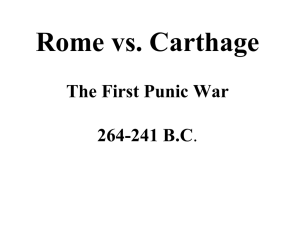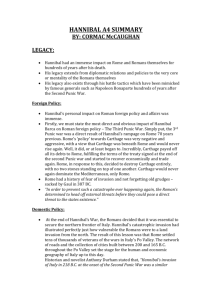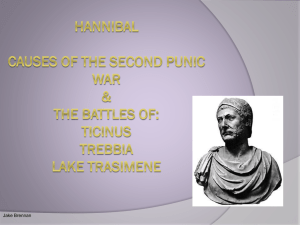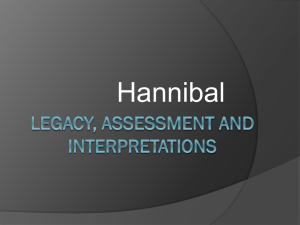M. Hulls on C. Stocks, The Roman Hannibal
advertisement
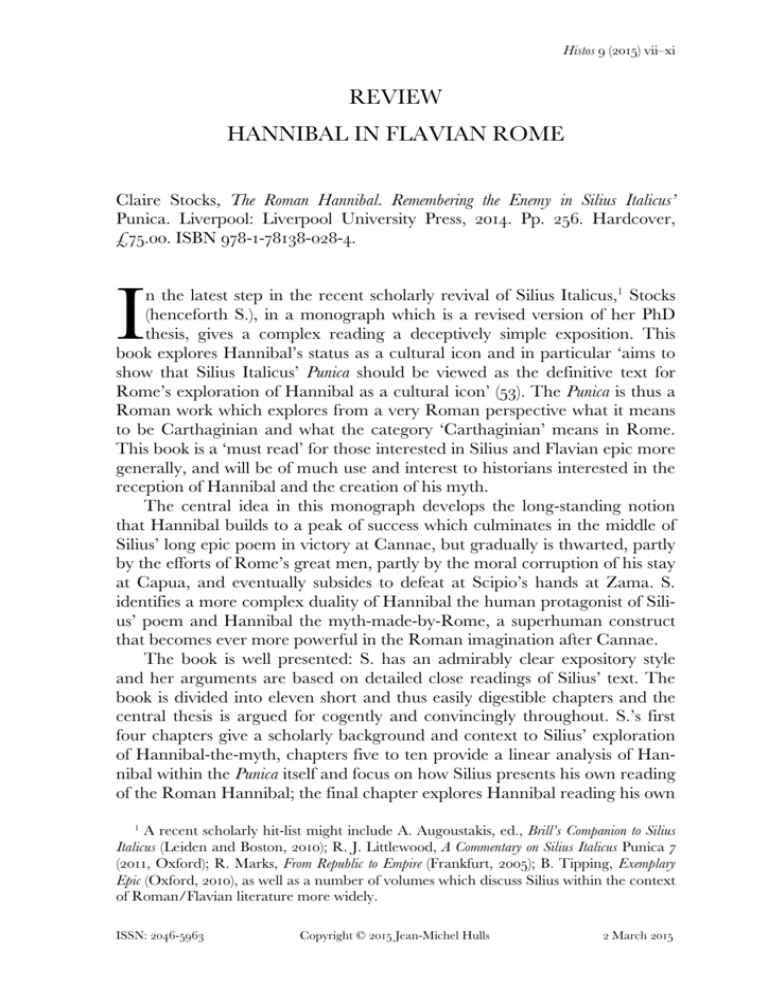
Histos 9 (2015) vii–xi REVIEW HANNIBAL IN FLAVIAN ROME Claire Stocks, The Roman Hannibal. Remembering the Enemy in Silius Italicus’ Punica. Liverpool: Liverpool University Press, 2014. Pp. 256. Hardcover, £75.00. ISBN 978-1-78138-028-4. I n the latest step in the recent scholarly revival of Silius Italicus,1 Stocks (henceforth S.), in a monograph which is a revised version of her PhD thesis, gives a complex reading a deceptively simple exposition. This book explores Hannibal’s status as a cultural icon and in particular ‘aims to show that Silius Italicus’ Punica should be viewed as the definitive text for Rome’s exploration of Hannibal as a cultural icon’ (53). The Punica is thus a Roman work which explores from a very Roman perspective what it means to be Carthaginian and what the category ‘Carthaginian’ means in Rome. This book is a ‘must read’ for those interested in Silius and Flavian epic more generally, and will be of much use and interest to historians interested in the reception of Hannibal and the creation of his myth. The central idea in this monograph develops the long-standing notion that Hannibal builds to a peak of success which culminates in the middle of Silius’ long epic poem in victory at Cannae, but gradually is thwarted, partly by the efforts of Rome’s great men, partly by the moral corruption of his stay at Capua, and eventually subsides to defeat at Scipio’s hands at Zama. S. identifies a more complex duality of Hannibal the human protagonist of Silius’ poem and Hannibal the myth-made-by-Rome, a superhuman construct that becomes ever more powerful in the Roman imagination after Cannae. The book is well presented: S. has an admirably clear expository style and her arguments are based on detailed close readings of Silius’ text. The book is divided into eleven short and thus easily digestible chapters and the central thesis is argued for cogently and convincingly throughout. S.’s first four chapters give a scholarly background and context to Silius’ exploration of Hannibal-the-myth, chapters five to ten provide a linear analysis of Hannibal within the Punica itself and focus on how Silius presents his own reading of the Roman Hannibal; the final chapter explores Hannibal reading his own 1 A recent scholarly hit-list might include A. Augoustakis, ed., Brill’s Companion to Silius Italicus (Leiden and Boston, 2010); R. J. Littlewood, A Commentary on Silius Italicus Punica 7 (2011, Oxford); R. Marks, From Republic to Empire (Frankfurt, 2005); B. Tipping, Exemplary Epic (Oxford, 2010), as well as a number of volumes which discuss Silius within the context of Roman/Flavian literature more widely. ISSN: 2046-5963 Copyright © 2015 Jean-Michel Hulls 2 March 2015 viii Jean-Michel Hulls life and legacy. What follows is a more detailed analysis of the book; any criticisms are intended to benefit work which is already useful, intelligent, and enjoyable to read. Chapter 1, ‘The Roman Hannibal Defined’, sets up the contrast between Hannibal as awe-inspiring nomen, an important theme throughout, and as individual. Comparisons are made with Caesar and Catiline in this regard, but more interestingly and productively with Virgil’s Dido and Seneca’s Medea. The word nomen provides a sense of self-exemplarity and Roman readers examine the historical Hannibal’s life knowing that he will become an exemplar in the future. Silius’ Hannibal creates his own myth but fails to live up to it; the myth lives on but the man declines in the second half of the poem. More potently, Hannibal becomes the example which his Roman Republican opponents try to live up to. The contrast between Roman viri and the Carthaginian unus vir is central to S.’s argument, but we might make more of this contrast as a metapoetic statement of intent, opposing the Virgilian, imperial logic of singularity against more traditional (Ennian?) or radical (Ovidian? Lucanian?) pluralities. Chapter 2, ‘Before Silius: the Creation of the Roman Hannibal’, gives a brief overview of the literary background, beginning with the fragmentary Greek authors Sosylus and Silenus and the Roman mythologisation of Hannibal, and traces an account of a dream of Hannibal from Silenus (preserved through Cicero via Coelius Antipater) and its development in Livy, Valerius Maximus, and Silius. S. then takes us to Polybius, who sets up the notion of the Second Punic War as a fight between Rome and Hannibal alone, the relative absence of moralisation and extremes of characterisation in his history, and the idea of Scipio as Hannibal’s ultimate opponent. S. briefly explores Hannibal’s appearances in other genres, particularly the works of Cicero, Nepos, Horace, Valerius Maximus, and Seneca. For Cicero, Hannibal is the epitome of cruelty, for Nepos he is a superhuman force, largely defeated by the jealousy of his fellow Carthaginians. Horace exploits the epithets dirus, durus, and perfidus, Valerius depicts a contradictory character of extremes of cruelty and humanity while Seneca sensationalises the former. Chapter 3, ‘Silius’ Influences’, focuses on Livy. S. depicts a stark generic contrast between Livy’s historiography and Silius’ epic2 as exemplified in differences in structure and emphasis on chronology. What come out more in S.’s analysis are the similarities: the model of ascent and decline is visible in the ten Livian books on the second war;3 both depict Hannibal as a kind of superman; both have Cannae as a focal point; both play on the notion of plural versus individual heroes. Livy forms a clear point of inspiration for Sil2 E.g. 35: ‘Livy’s ab Urbe Condita is historiography; Silius’ Punica is epic’. More could be done with the notion of Iliadic and Odyssean halves of the Punica; see E. K. Klaassen, ‘Imitation and the Hero’, in Augoustakis (2010) 99–126. 3 Review of Stocks, The Roman Hannibal ix ius’ duality of mythical and historical hero, especially perhaps in the books of his fourth decade where he opposes the Hannibal the impotent man with Hannibal the terrifying myth. Although detailed and thoughtful, the artificial separation of prose historiography and epic verse seems heavy-handed and might be better refined with reference to some of the recent scholarship on the blurring of distinctions between history and poetry.4 Chapter 4, ‘Epic Models’, looks back to Homer, Virgil, and Latin epicists of the first century. Hannibal’s models, Hector and Achilles, Aeneas and Turnus, Caesar and Pompey, and the seven against Thebes5 are fairly obvious and this feels like reasonably well-trodden ground; Hannibal looks increasingly superhuman and emulates and subverts his authoritative literary forbears in equal measure. More interestingly, S. explores the paradox that Hannibal is an important model in the Punica for the Romanitas Jupiter expounds in book 3 and is regularly imitated by his Roman opponents. The discussion of the relationship between Hannibal and Valerius Flaccus’ Medea (and their respective relationships with Juno) is tantalising. Hannibal is perhaps at his most intriguing when he confounds our expectations, just as in the gender-bending similes which compare him to a tigress or in his display of improba virtus, which links him inextricably to Statius’ youthful, virginal Parthenopaeus. This chapter in particular has a feeling of unfinished business about it. The first 79 pages are more synthetic than analytical and, while some big ideas are introduced here, Silian experts may feel comfortable skipping through quickly to the main events which follow. Chapter 5, ‘Silius’ Roman Hannibal’, looks at the establishment of Hannibal the myth in the Punica. S. looks at the youthful Hannibal in book 1, gives a clever and nuanced reading of Anna Perenna in book 8, and explores the scene with Hannibal’s wife and son in book 3. S. eloquently underlines each main idea in her analysis: the mythic potency of Hannibal is actualised in his nomen and Hannibal is transformed by his reputation into a living instantiation of his city and into a moles which crushes all opposition on the battlefield.6 Meanwhile, the influences of Juno, Dido, and Hamilcar on the young Hannibal metapoetically represent the influences of epic and history. 4 See J. F. Miller and A. J. Woodman, edd., Latin Historiography and Poetry in the Early Empire (2010, Leiden), especially the chapter by J. Jacobs, ‘From Sallust to Silius Italicus: Metus Hostilis and the Fall of Rome in the Punica’, J.-M. Hulls, ‘How the West was Won and Where it Got Us: Compressing History in Silius Italicus’ Punica’, Histos 5 (2011): 283–305, and D. Konstan and K. A. Raaflaub, edd., Epic and History (2014, London). 5 On the theme of theomachy, see now P. Chaudhuri, The War with God (Oxford, 2014), esp. 231–55. 6 Silius’ use of moles is an important topic throughout, although one might further consider a comparison with Domitian’s equestrian statue, depicted as moles by Statius at Silvae 1.1. x Jean-Michel Hulls Finally, Hannibal, through his manly virtues, becomes a kind of pseudoRoman. The book’s genesis as a PhD thesis is probably evident in the occasionally over-long footnotes, but the short chapters allow us to focus on each idea with real clarity. The looming Augustan background might have more to offer. Silius’ phrase medio finem bello (Pun. 1.12) suggests not only Cannae as the middle point of the middle war with Carthage, but also the poem as a mid-point between Aeneas and imperial Rome. Hannibal’s subtle subversion of Augustan epic ideals is worth further exploration, especially given the Augustan values being espoused by Silius’ Flavian rulers. Chapter 6, ‘Out of the Darkness and into the Light’, explores Hannibal in the early part of the war to the end of Cannae while chapter 7, ‘Hannibal’s Decline after Cannae: Separating Man and Myth’, examines Hannibal at Capua and his brother Mago in Carthage. Hannibal constructs his own mythic self at Saguntum while Rome’s viri are entirely absent from the opening three books of the poem. Hannibal himself becomes virtually indistinguishable from Carthage itself while his Roman opponents at Ticinus, Trebia, Trasimene, and Cannae are all (usually poor-quality) imitators of him. The differences between Roman and Hannibal become blurred. Yet, as the myth gains in potency, Hannibal, even before Cannae, loses personal power. As he sojourns at Capua, man and myth (expounded especially as Hannibal ad portas) separate and others, notably Hasdrubal and Marcellus, seek to fill the gap Hannibal leaves while others, such as Mago, propagate the myth in Hannibal’s absence. These are perhaps the best chapters in the book, although S. avoids the obvious comparisons to be made with that other ‘great’ Roman construction, Alexander of Macedon, and the metapoetic inference that, if Hannibal is a singular representative of Romanitas, then perhaps his slide into degeneracy at Capua stands in some way for Rome’s proverbial fall from moral grace after the defeat at Cannae. Our progress through Silius’ text continues in chapter 8, ‘Imitators and Innovators’, which looks at Marcellus in Sicily, chapter 9, ‘Band of Brothers’, which briefly examines the other Barcids, and chapter 10, ‘The Fulmina of War’, on Scipio and Hannibal in the final three books of the poem. Marcellus is pseudo-Hannibal to Hannibal’s pseudo-Roman, but a more sanitised, Ciceronean version than the monstrous Livian conqueror. Hasdrubal is more imitator than innovator while Mago, enjoying a more prominent role than in Livy, does much to propagate the myth of his elder brother. Meanwhile it is the arrival of Scipio as the dominant force in the narrative that underlines the split between Roman myth and Carthaginian man. A dynamic Scipio overwhelms the static, impotent Hannibal. There are a number of adept and subtle readings in chapter 10, particularly Scipio’s interaction with the ghost of Hamilcar showing Hannibal as simultaneously, paradoxically, the best and worst of men, Hannibal’s becoming an exile when he finally leaves Italy, the double meaning of 17.338 Hannibal haec as both ‘Hannibal Review of Stocks, The Roman Hannibal xi said these things’ and ‘these things are Hannibal’, and Scipio’s triumph as a quasi-funeral for Hannibal. The final chapter, ‘the Man and his Myth: the Self-Defined Roman Hannibal’, and the book’s conclusion promise the most but in some ways deliver the least. S. in chapter 11 looks at four moments in the text where Hannibal views his own life and legacy: in books 1 and 3, where Hannibal chooses Hercules as his role model, book 6, when he looks back at a depiction at Liternum of the First Punic War, book 12, when he reviews his failed assault on Rome, and book 17, when the dejected, suicidal Hannibal watches the battle of Zama. Each reading is well made7 as is the essential point that Hannibal, when his own spectator, consistently misinterprets what is happening, but each analysis is rather brief and the chapter feels like an opportunity missed. One could build in fascinating ways upon the basic dichotomy of man versus myth by exploring in greater depth how Hannibal operates simultaneously as protagonist, interpreter, and narrator of his own exploits. Overall, the book is very readable and has remarkably few typographical errors.8 S. makes her central point concerning the construction of Hannibal as a Roman myth and the myth operating in parallel to the protagonist in the Punica with undeniable force. The argument is clear, confident, and backed up by a series of well-researched close readings of a complex text. If this reader has one caveat, it is that the book does not go far enough at times, resisting the urge to prove that Silius’ Punica is the definitive text for Rome’s exploration of Hannibal as a cultural icon. That challenge still awaits, but The Roman Hannibal provides solid foundations on which scholars can build further. In the meantime, S. has given a book that will be extremely useful within the ever-expanding field of Flavian epic and will have much to offer students of Hannibal, whether man or myth. Dulwich College 7 JEAN-MICHEL HULLS HullsJ@dulwich.org.uk Although the discussion of Hannibal at Gades in book 3 would be improved by reference to B. J. Gibson, ‘Hannibal at Gades: Silius Italicus 3.1–60’, PLLS 12 (2005): 177–96. 8 This reader found the following: on 121, for ‘Trebia’ read ‘Trasimene’; 190, references should be to ‘Silvae 4.6.77–8’ and ‘Silvae 4.6.79’; 206, the translation of 17.263 as ‘chomp down’ seems a little off-register; 207 ‘silentia’ should be completely underlined; 208 the translation should read ‘of glory”, 17.292–4)” not ‘of glory”, (17.292–4)’; 218, for ‘eight’ read ‘ten’; 219, for ‘exulted’ read ‘exalted’; 232, for ‘synedochic’ read ‘synecdochic’; 244, Littlewood’s commentary was published in 2011, not 2001.

